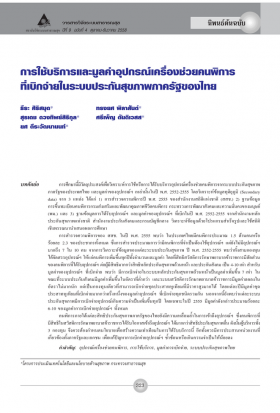ธีระ ศิริสมุด
ทรงยศ พิลาสันต์
สุรเดช ดวงทิพย์สิริกุล
ศรีเพ็ญ ตันติเวสส
ยศ ตีระวัฒนานนท์
Abstract:
การศึกษานี้มีวัตถุประสงค์เพื่อวิเคราะห์การใช้หรือการได้รับบริการอุปกรณ์เครื่องช่วยคนพิการจากระบบประกันสุขภาพภาครัฐของประเทศไทย และมูลค่าของอุปกรณ์ฯ เหล่านั้นในปี พ.ศ. 2552-2555 โดยวิเคราะห์ข้อมูลทุติยุภูมิ (Secondary data) จาก 3 แหล่ง ได้แก่ 1) การสำรวจความพิการปี พ.ศ. 2555 ของสำนักงานสถิติแห่งชาติ (สสช.) 2) ฐานข้อมูลการขึ้นทะเบียนคนพิการกรมส่งเสริมและพัฒนาคุณภาพชีวิตคนพิการ กระทรวงการพัฒนาสังคมและความมั่นคงของมนุษย์ (พม.) และ 3) ฐานข้อมูลการได้รับอุปกรณ์ฯ และมูลค่าของอุปกรณ์ฯ ที่เบิกในปี พ.ศ. 2552-2555 จากสำนักงานหลักประกันสุขภาพแห่งชาติ สำนักงานประกันสังคมและกรมบัญชีกลาง วิเคราะห์ข้อมูลด้วยโปรแกรมสำเร็จรูปและใช้สถิติเชิงพรรณนานำเสนอผลการศึกษา การสำรวจความพิการของ สสช. ในปี พ.ศ. 2555 พบว่า ในประเทศไทยมีคนพิการประมาณ 1.5 ล้านคนหรือร้อยละ 2.3 ของประชากรทั้งหมด ซึ่งการสำรวจประมาณการว่ามีคนพิการที่จำเป็นต้องใช้อุปกรณ์ฯ แต่ยังไม่มีอุปกรณ์ฯ มากถึง 7 ใน 10 คน จากการวิเคราะห์ข้อมูลของแต่ละระบบประกันสุขภาพ ปี พ.ศ. 2552-2555 พบว่าทั้งสามกองทุนได้จัดสรรอุปกรณ์ฯ ให้แก่คนพิการเพิ่มขึ้นทุกปีทั้งจำนวนและมูลค่า โดยที่สิทธิสวัสดิการรักษาพยาบาลข้าราชการมีสัดส่วนของคนพิการที่ได้รับอุปกรณ์ฯ ต่อผู้มีสิทธิมากกว่าสิทธิหลักประกันสุขภาพถ้วนหน้า และประกันสังคม เป็น 4-10 เท่า สำหรับมูลค่าของอุปกรณ์ฯ ที่เบิกจ่าย พบว่า มีการเบิกจ่ายในระบบหลักประกันสุขภาพถ้วนหน้าเป็นมูลค่าเพิ่มขึ้น 7 เท่า ในขณะที่ระบบประกันสังคมมีมูลค่าเพิ่มขึ้นในอัตราที่ต่ำกว่า และระบบสวัสดิการรักษาพยาบาลข้าราชการมีมูลค่าลดลงในอัตราไม่มากนัก แต่เป็นกองทุนเดียวที่สามารถเบิกจ่ายชุดประสาทหูเทียมที่มีราคาสูงมากได้ โดยแต่ละปีมีมูลค่าชุดประสาทหูเทียมที่เบิกจ่ายมากกว่าครึ่งหนึ่งของมูลค่าอุปกรณ์ฯ ที่เบิกจ่ายทุกชนิดรวมกัน นอกจากนี้ยังพบว่าแต่ละระบบประกันสุขภาพมีการเบิกจ่ายอุปกรณ์เกินความจำเป็นเพิ่มขึ้นทุกปี โดยเฉพาะในปี 2555 มีมูลค่าดังกล่าวประมาณร้อยละ 6-10 ของมูลค่าการเบิกจ่ายอุปกรณ์ฯ ทั้งหมด คนพิการภายใต้แต่ละสิทธิประกันสุขภาพภาครัฐของไทยยังมีความเหลื่อมล้ำในการเข้าถึงอุปกรณ์ฯ ซึ่งคนพิการที่มีสิทธิในสวัสดิการรักษาพยาบาลข้าราชการได้รับโอกาสเข้าถึงอุปกรณ์ฯ ได้มากกว่าสิทธิประกันสุขภาพอื่น ดังนั้นผู้บริหารทั้ง 3 กองทุน จึงควรต้องกำหนดนโยบายเพื่อสร้างความเท่าเทียมในการได้รับบริการนี้ อีกทั้งควรมีการประสานหน่วยงานที่เกี่ยวข้องทั้งภาครัฐและเอกชน เพื่อแก้ปัญหาการเบิกจ่ายอุปกรณ์ฯ ซ้ำซ้อนหรือเกินความจำเป็นให้น้อยลง
Abstract:
The study aims to investigate an accessibility of assistive technology for people with disabilities and the costs of assistive technology during 2009-2012. The secondary data was derived from three main sources: 1) Disability survey data (2012) from National Statistical Office-NSO 2) Registration of National Office for Empowerment of Persons with Disabilities-NEP, Ministry of Social Development and Human Security, and 3) Database from the budget of assistive devices to people with disabilities: National Health Security Office-NHSO, Social Security Office and The Comptroller General’s Department. In addition, the data was analyzed and presented with descriptive statistics. According to disability survey data (2012), there were 1.5 million people with disabilities in which accounted for 2.3 % of the population in Thailand. Moreover, the estimation survey showed that 7 out of 10 people with disabilities were still in needs of assistive devices. According to the analysis of three main health benefit packages in Thailand (Universal Coverage Scheme-UC, Social Security Scheme-SSS and Civil Servant Medical Benefit Scheme-CSMBS), they annually subsidized with an increasing support of assistive devices to people with disabilities. The budget subsidized on CSMBS patients was 4 to 10 times higher than the budget supported to UC and SSS patients. According to the expenditures of assistive technology: UC’s expenses increased 7 times, SSS’s expenses rose at the lower rate, and CSMBS’s expenses slightly reduced. However, only CSMBS reimbursed the high price cochlear implant sets that accounted for more than half of the total costs of devices. Moreover, it is found that cost from an overuse of the assistive devices in each main health benefit package was increased every year, especially in 2011 the cost was 6-10 percent of total cost of devices. People with disabilities under Thailand’s health benefit packages still have an unequal access to assistive devices. People with disabilities under CSMBS gained more access to assistive devices than other insurance schemes. Henceforth, the decision makers of Thailand’s main three health benefit schemes need to revise the policy to make more equal benefits. Moreover, it is necessary to collaborate with both public and private sectors to solve an inappropriate use (overuse) of the assistive devices that continues to cause more costs each year.





